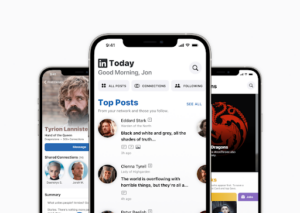
Microblogging is a convenient and efficient way to share quick updates, ideas, and snippets of information. If you use popular platforms like X (formerly known as Twitter), Tumblr, Instagram, or even Facebook, microblogging is already part of your social media strategy. With posts usually written in 300 characters or less, this tool empowers you, as a brand owner or marketer, to connect with your audience mindfully and effectively.
In today’s hyper-connected world, many people prefer to consume short content, and this is where microblogging demonstrates its value, particularly when:
Some key features of microblogging:
Microblogging has five primary uses:
So what are the most popular microblogging platforms today? Let’s start with X, Tumblr, Threads, Mastodon, and Bluesky; followed by Reddit, Pinterest, LinkedIn, Instagram, and Facebook.
Following his fraught 2022 acquisition of Twitter, Elon Musk set in motion a tsunami of changes, renaming the platform “X” among them. Let’s recap what has happened to date, including how (if you so choose) to manage brand presence on today’s X, as well as alternative platforms to consider amid changing user behavior.
Brand Decisions:
Platform Alternatives:

Given the ongoing upheaval and change on X, many brands have made significant choices about what to do with their accounts and how to support the audiences they’ve built on the platform. Many brands have been active on X since its launch in 2006, so it’s challenging to abruptly change after two decades of engagement.
As with any significant marketing decision, it helps to break the challenge down into smaller choices, each with its own criteria. Here, we can focus on three areas: Audience, Advertising, and Accounts. (In the next section, we’ll discuss potential Alternatives to X.)
Brands continue to make choices in handling existing X channels—choices that don’t always correlate with the size of the channel following.
Notably, in an announcement in fall of 2023, IBM stated:
“IBM has zero tolerance for hate speech and discrimination, and we have immediately suspended all advertising on X while we investigate this entirely unacceptable situation.”
The primary IBM X account (@IBM) has not posted since Nov. 15, 2023.
The followers of a brand account like IBM’s have expectations of both the platform and the brand. This interwoven relationship can create decision complexity, but organizations will be most successful if they focus on audience expectations of the brand first and expectations of the platform second.
To discuss X as a platform, we must discuss how it makes money.
X is, and always has been, a business supported by advertising. Despite Elon Musk’s desire to shift the majority of revenue to a subscription-based model, subscriptions are essentially a rounding error compared to revenue driven by other sources.
In fact, X has not booked an annual profit since 2019 and has posted a loss for most of the past decade. Before Musk’s takeover, Twitter (now X) took in 90% of its revenue—$4.51 billion—from advertisers. Data licensing and all other services brought in $572 million, a notable sum since X has made significant strides in monetizing its data offerings.
Last summer, Musk hired Linda Yaccarino, former chairman of global advertising and partnerships for NBCUniversal, as CEO of X. Since taking the helm, Yaccarino has struggled to get advertisers to return, particularly in light of Musk’s increasingly adversarial relationship with them.
This stance threatens to have significant legal implications beyond the impact on brand reputation. Since location or user-attributable phone numbers aren’t necessary to provide the service X does, these actions could be defined as illegal under the General Data Protection Regulation (GDPR) in Europe and the California Privacy Rights Act (CPRA). Both of these regulations state that consumers have the right to “direct a business that collects personal information to limit its use,” even if there is a subscription product that turns off ads. Penalties for violating GDPR can extend beyond the advertising platform to the actual advertising brand itself, so the implications of these decisions could be widespread.
Exiting X? Typically, brands have chosen one of three options:
As IBM has chosen to do, some brands no longer post to brand accounts. If the brand is using this as a “wait and see” approach, best practices suggest leaving the account visibility set to “Public” so that your audience can scroll back through post history and so that you don’t lose followers due to their thinking that you’re “not coming back.” If this is your pathway forward, it’s best to “pin” a post with a brand statement to the top of your post history regarding the platform so users visiting your profile find that statement first.
 Brands may clarify that they aren’t using a specific X handle or are consolidating the brand presence to fewer handles. For accounts brands wish to consider Dormant, the post history visibility can be set to “Private,” thus hiding all previous posts from view. Most brands doing this update the bio with directions on the next steps, such as Air New Zealand did (right) when transitioning to a new handle.
Brands may clarify that they aren’t using a specific X handle or are consolidating the brand presence to fewer handles. For accounts brands wish to consider Dormant, the post history visibility can be set to “Private,” thus hiding all previous posts from view. Most brands doing this update the bio with directions on the next steps, such as Air New Zealand did (right) when transitioning to a new handle.
There are some important considerations for brands choosing to delete the brand accounts completely. First, any handle @name deleted goes back into the “pool” of available names for any new account signing up. That means if you delete your brand handle, it’s possible (and likely if the handle was popular or was a common word) that another user will claim the handle.
If this happens, there is an official process for reclaiming such a handle under X’s Trademark Infringement Policy. However, the teams once supporting this process may no longer be employed by X.
No matter your brand’s decision, it is imperative to log in regularly to any brand handle that has not been deleted. According to X’s Inactive Account Policy, any handle that has not seen a log-in for over six months will be deleted automatically. That handle @name then will return to the “pool” of available names. Should your brand choose to be quiet or dormant on X, you need to build a process for a user to log into that account at least once every six months to retain it.
Users of all levels of fame and following have now left X, and many have sought alternative platforms to connect and express themselves. Brands are no different, as many are making similar decisions along with trying to follow audiences where they are going in order to engage in new environments.
“This is the first time in internet history that users are fleeing a social network without a clear place to go.”
–Nilay Patel, Editor-in-Chief, The Verge
Within this section, we have included a summary of nine social media platforms in the microblogging arena that offer an alternative to X. This can be a valuable resource as you present options to your peers and colleagues, and we will continue to publish new versions as more platforms launch.
Some of these platforms are worth a closer look. Even if your brand opts to remain on X, starting (or rebooting) your brand channel on one of these platforms is a smart strategy in 2024.
Bluesky serves as the perfect segue from X to its competitors in the microblogging space, as it is the brainchild of Twitter co-founder and former CEO Jack Dorsey. Dorsey introduced the idea of a decentralized (open-source algorithm) social media platform in 2019 while still CEO at Twitter. Bluesky was ultimately founded in October 2021, headed by first-time CEO Jay Graber (founder of Happening, Inc.), with Dorsey serving as a board member*. The nature of the decentralized protocol allows for multiple social networks to operate in its ecosystem, and Bluesky operates its own network called Bluesky Social.
The platform launched as invitation-only but opened to the general public in February 2023. Its user interface is similar in appearance and structure to X but lacks some of X’s more advanced features, like direct messaging and creating account lists. Unlike X, it offers a tool that gives users the ability to create and manage independent moderation, which provides “unprecedented control” over the social media experience.
While Elon Musk wants to shift the majority of revenue to subscription-based instead of the original advertising-based model, Bluesky aims to avoid advertising-based revenue and instead make money by offering paid services. The first of these paid services launched in the summer of 2023, offering custom domains to users who want a unique domain as their handle on the service.
Certain users, especially those of a more technical bent, sought an open-source alternative to X immediately following its acquisition (and subsequent rebrand). Enter Mastodon. This decentralized, open-source social media platform was founded in 2014 but more recently exploded with users seeking a new place to post. Despite Mastodon’s own help page clearly stating it is not X, some people and brands are finding it an easier shift thanks to the similar posting format.
Mastodon operates fundamentally differently than X or many other social networks. Specifically, it is based on an interconnected “fediverse” (a portmanteau of “federation” and “universe”) of thousands of independent servers running the software called Mastodon Instances. Each Instance administrator controls all content on that Instance, but Instances are also interconnected, and users on one Instance can see content created elsewhere.
While this structure can be counter-intuitive for users of traditional social networks, it could also be Mastodon’s secret weapon. Each Instance can serve the desires of its users, with content and moderation tailored to fit a specific view or cohort. Brands working with these communities lose some of the control they experienced on single-instance traditional networks but have an opportunity to find deeper connections and greater loyalty with specific audience segments.
Precise user statistics are difficult to gather on a federated platform such as Mastodon, but according to SimilarWeb, the most popular Instance (mastodon.social) has:
Created by Meta Platforms in 2023, Threads is similar in format and function to X and is meant to serve as a direct competitor. The app is linked to user Instagram accounts and offers more emphasis on visual elements than X, given its derivation from the largely image-based platform Instagram. Threads and replies can include short pieces of text, links, photos, videos, or any combination of them.
The app is linked to user Instagram accounts and offers more emphasis on visual elements than X, given its derivation from the largely image-based platform Instagram. Threads and replies can include short pieces of text, links, photos, videos, or any combination of them.
Social marketers may remember Tumblr from its 2013 sale to Yahoo for a $1 billion valuation, but many have not given it much thought since. Tumblr went into a hibernation of sorts while it traded hands from Yahoo to Verizon. In 2019, Automattic, the company that founded and runs WordPress, acquired Tumblr for a mere $3 million.
thought since. Tumblr went into a hibernation of sorts while it traded hands from Yahoo to Verizon. In 2019, Automattic, the company that founded and runs WordPress, acquired Tumblr for a mere $3 million.
Since then, Tumblr has benefitted from strategic investments in its long-term success. Automattic, using a deep background in web infrastructure, has been able to rewrite most of Tumblr’s code base to make it more stable — to the point where it can support more than 200,000 new signups per day. Tumblr also invested heavily in content moderation, creating an environment that is more “brand safe” than X. For a fascinating take on that subject, read “Why ‘Go Nuts, Show Nuts’ Doesn’t Work” from Tumblr/Automatic CEO Matt Mullenweg.
 Another “legacy” social network seeing a resurgence is Reddit, particularly following its IPO last month. However, this platform may have been larger than you think. In 2018, Reddit surpassed Twitter (now X) in total users and is home to more than 430 million users, with 39% monthly active users.
Another “legacy” social network seeing a resurgence is Reddit, particularly following its IPO last month. However, this platform may have been larger than you think. In 2018, Reddit surpassed Twitter (now X) in total users and is home to more than 430 million users, with 39% monthly active users.
Reddit also excels as an open platform. Content on the site is almost entirely visible to search engines, driving reddit.com to become the ninth most-visited website in the U.S., with over 166 million monthly visits, according to Ahrefs.
 Pinterest is different from other microblogging platforms in that it is purely image-based. It allows the user to create collections of images around specific topics and follow the topics and profiles of others. The platform refers to itself as a visual discovery engine for finding “Pins,” ideas, and inspiration on the user’s topics of interest. Users can create their own Pins to share.
Pinterest is different from other microblogging platforms in that it is purely image-based. It allows the user to create collections of images around specific topics and follow the topics and profiles of others. The platform refers to itself as a visual discovery engine for finding “Pins,” ideas, and inspiration on the user’s topics of interest. Users can create their own Pins to share.
The platform provides different profile options for brands and individuals, making it equally useful for social and commercial image-based microblogging.
 Though more conducive to longer posts, LinkedIn is possibly the best microblogging platform for working professionals, service providers, and freelancers. It allows users to post detailed articles or start a newsletter to share content consistently. LinkedIn posts also have longer life cycles than those on other platforms.
Though more conducive to longer posts, LinkedIn is possibly the best microblogging platform for working professionals, service providers, and freelancers. It allows users to post detailed articles or start a newsletter to share content consistently. LinkedIn posts also have longer life cycles than those on other platforms.
 Microbloggers love Instagram because of the variety of methods they can use to create content. The platform is more content-focused than other platforms, allowing users extensive opportunities for creativity. Similar to Pinterest, posts are primarily image-based. However, unlike Pinterest, Instagram also grants a robust 2200-character-limited text-based caption to accompany an image (or video), allowing the poster to add significant context or supplemental information.
Microbloggers love Instagram because of the variety of methods they can use to create content. The platform is more content-focused than other platforms, allowing users extensive opportunities for creativity. Similar to Pinterest, posts are primarily image-based. However, unlike Pinterest, Instagram also grants a robust 2200-character-limited text-based caption to accompany an image (or video), allowing the poster to add significant context or supplemental information.
 The world’s most popular social network, Facebook, demonstrates its value as a microblogging platform (of sorts) by allowing users to share information with their audience in multiple formats, such as text-based updates, photos, GIFs, videos, or a simple reaction. Facebook also offers a generous character limit of 63,206 for text-based posts.
The world’s most popular social network, Facebook, demonstrates its value as a microblogging platform (of sorts) by allowing users to share information with their audience in multiple formats, such as text-based updates, photos, GIFs, videos, or a simple reaction. Facebook also offers a generous character limit of 63,206 for text-based posts.
The way people consume content has shifted, and today we are drawn toward bite-sized posts that take little time and effort to understand. If your brand is interested in updating your microblogging strategy, here are some key things to do:
If you want to update your brand strategy and/or social accounts, Social Factor can help you make those transitions with minimal disruption to your team and customers.
Contact us: sales@socialfactor.com
*As of May 4, 2024, Jack Dorsey is no longer on the Bluesky Board of Directors